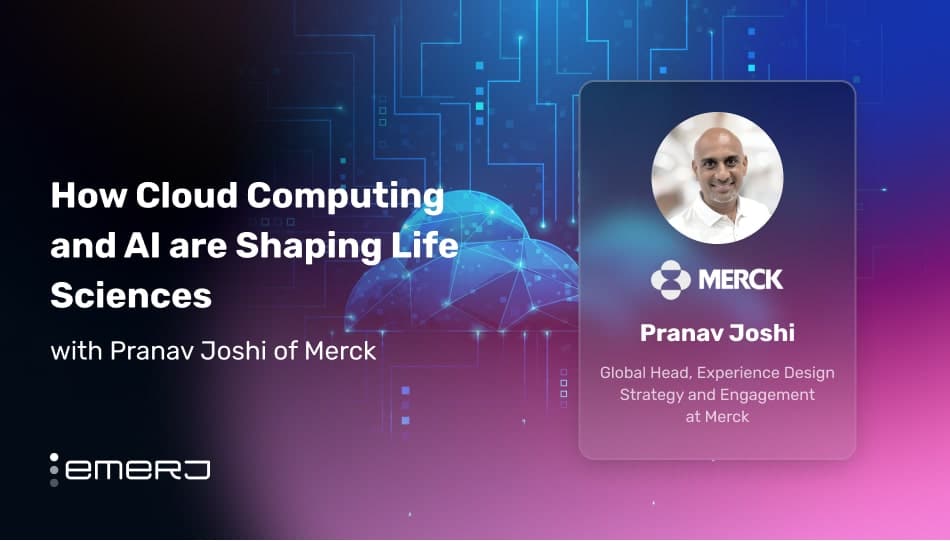This interview analysis is sponsored by Deloitte and was written, edited, and published in alignment with our Emerj sponsored content guidelines. Learn more about our thought leadership and content creation services on our Emerj Media Services page.
R&D in life sciences, especially biopharmaceuticals, is a highly challenging and complex endeavor. Researching and developing drugs is inherently far riskier and more expensive than in nearly every other business sector. The success rate for new drug approval is notoriously low, with only a fraction of drug candidates surviving clinical trials and ultimately gaining FDA approval. According to a 2011 study from the Biotechnology Industry Organization Industry Analysis and BioMedTracker, the rate of FDA approvals of new drugs plummeted to 10% between 2003 and 2010 – down from 20-16% in previous years.
Given these challenges, life sciences companies are eagerly exploring the potential of artificial intelligence (AI) to revolutionize their R&D processes. AI, particularly generative AI (GenAI), has the potential to transform many aspects of drug discovery, development, and manufacturing, leading to faster, more efficient, and more cost-effective outcomes.
In this article, we’ll explore the potentially transformative role of AI in the life sciences space with insights from a conversation with AI in life sciences veteran Andrew Bolt of Deloitte with Emerj CEO and Head of Research Daniel Faggella on the ‘AI in Business’ podcast.
We examine three actionable takeaways for life science executives from our interview:
- Accelerating drug discovery: Leveraging GenAI’s ability to analyze vast amounts of data and identify patterns in drug discovery by identifying new targets, optimizing lead compounds, and predicting clinical trial outcomes with greater accuracy and efficiency.
- Enhancing clinical trials with AI and real-world data: By integrating real-world data (RWD) with clinical trial data and leveraging AI’s capabilities, life sciences companies can enhance clinical trials by improving trial efficiency and effectiveness, identifying potential study participants with greater accuracy, and gaining a more comprehensive understanding of disease.
- Streamlining regulatory compliance: Strengthening and simplifying regulatory compliance by using GenAI to facilitate the translation of regulatory documents, interpret regulatory requirements, and anticipate potential questions and challenges of regulators.
Listen to the full episode below:
Guest: Andrew Bolt, Partner at Deloitte
Expertise: R&D strategy, drug discovery, pharmacology, life sciences, generative AI (GenAI), AI strategy
Brief Recognition: Andrew is a Principal in Deloitte’s Life Sciences Strategy practice and leader of the R&D Practice. He has more than 20 years of experience working in the life sciences industry and his career spans from bench scientist to CEO. Prior to Deloitte, Andrew served as the CEO and founder of SphynKx Therapeutics, an early-stage biotechnology company. He began his career as a cancer biologist with Millennium Pharmaceuticals. Andrew also has an MBA from the Darden School of Business at UVA, in addition to an M.S. in Pharmaceutical Sciences and a B.S. in Molecular Biology, both from the University of Connecticut.
Accelerating Drug Discovery
Mr. Bolt begins by citing a common refrain heard within pharmaceutical circles: the painfully slow, expensive, and inaccurate process of drug discovery. Andrew notes the oft-cited figure of “over $2 billion” required to bring a product to market – and with a terrible success rate (i.e., FDA approval) of 5% or lower.
He cites Pfizer’s and Moderna’s vaccine development amidst the international calamity that was COVID as a demonstration of what’s possible in the future. More specifically, Andrew says that when R&D departments have the freedom to “forcefully apply (AI) tools,” the process of drug discovery and development accelerates considerably.
In other words, advanced AI in general – and GenAI in particular – provides the raw power required to collect, synthesize, and produce valuable insight outputs on vast stores of data that many companies have, but only few can act on. GenAI’s ability to analyze and synthesize to such a degree is representative of the innovative leap that GenAI represents over traditional methods, including older AI.
Andrew notes that GenAI’s capabilities are valuable to life science companies’ drug discovery process for two reasons:
- Patient and disease segmentation: Advanced algorithms can identify patterns and categorize patients so that “our patients that have a more homogeneous disease that has driver biology that these companies can then go after,” says Andrew. For example, AI has been used to identify subgroups of patients with cancer who are more likely to respond to specific treatments.
- Identifying targets: Following disease segmentation, the AI system can predict protein structures at a higher accuracy. As a result, researchers can generate and simulate hypotheses more likely to identify only the drugs bindable to molecular targets.
The result is a digitized system of operations – powered by cutting-edge AI – that equips scientists to build and deploy a model capable of rapidly identifying drug profiles that meet a particular set of parameters (e.g., safety profile, pharmacokinetics, etc.).
He elaborates on the potential results:
“The hope is, eventually, once these molecules go through development and (clinical trials), it creates this feedback loop. You start learning from your clinical successes and failures and are able to fine-tune the models to incorporate that information. Then creating a real powerful sort of learning system for drug discovery.”
– Andrew Bolt, Partner at Deloitte
Such a dynamic learning system capable of continually evolving and leveraging real-world outcomes, Andrew states, has the potential to optimize – if not transform – drug discovery and development strategies. For companies, this could mean a drastically more effective and efficient drug discovery process. Practically speaking, companies and patients could benefit by bringing new, improved drugs to market faster and cheaper.
Enhancing Clinical Trials with AI and Real-World Data
Andrew then discusses emerging efforts among clients to integrate different types of data, such as real-world data with genomic data, and clinical trial data with RWD. He states that these initial steps of data integration are proving to be challenging, however: “Clients are starting to sort of knit together just two types of data,” he tells the podcast audience, “and that’s proven to be a pretty heavy lift.”
Despite the challenges, RWD and clinical data integration continue. Andrew cites the use of de-analyzed electronic medical record (EMR) data, equipping researchers with the powerful ability to identify potential trial participants with greater accuracy. Combined with historical data on clinical sites known for effective recruitment, this data integration can help to improve the efficiency and effectiveness of clinical trials.
Besides clinical data, Bolt mentions several other data types that can be integrated:
- Insurance claims data: Contains information about diagnoses, treatments, and costs of care. Example: A patient’s insurance claim for a doctor’s visit for a sore throat.
- Patient-generated data: Information such as activity level, sleep patterns, and diet. Example: A patient’s recording of their daily steps from a Fitbit.
- Social determinants of health data: Information including socioeconomic indicators (e.g., income, education, housing). Examples: government data, research surveys, and community health centers.
“We’re redefining disease with multimodal data. We’re not just looking at one type of data; we’re looking at everything. We’re looking at electronic health records, claims data, social determinants of health, genomic data, proteomics, and metabolomics. We’re looking at everything to get a complete picture of the patient.”
– Andrew Bolt, Partner at Deloitte
The use of GenAI to combine RWD with clinical data is a critical strength in this context. With its ability to understand and generate natural language and process vast amounts of data, GenAI systems are able to gain a more comprehensive understanding of disease. By combining data from diverse sources, researchers can identify previously undiscoverable data patterns and relationships.
For companies, the integration of RWD with internal data stores can result in reduced costs, increased efficiency, and improved patient outcomes.
Streamlining Regulatory Compliance
Regulatory compliance is a significant concern for life sciences companies, particularly pharmaceutical firms. Financial penalties, reputation damage, product recalls, and legal liabilities such as lawsuits are typical results of companies found to be non-compliant with legislation.
Complicating the issue is that the life sciences sector is among the most strictly regulated sectors in industry – and regulations are constantly changing. This makes it difficult for companies to stay current on the latest requirements.
Bolt elaborates on ways that AI and GenAI are being used to assist life sciences companies in improving compliance processes:
- Building protocols in a more innovative way: GenAI can help identify potential risks and draft new text that includes all the updated information. Doing so ensures that the protocol is compliant with regulations, protects the safety of patients, and greatly assists the company in meeting regulatory requirements.
- Updating clinical trial documentation: GenAI can update clinical trial documentation by detecting changes to regulatory requirements and integrating said changes. This can ensure critical clinical trial documentation is updated and compliant.
- Generating first drafts based on both: GenAI can assimilate and analyze regulatory requirements as well as protocol and clinical trial documentation to draft a first copy of clinical trial documents. Adopted as an enterprise process, doing so can save considerable time and effort for researchers while also helping to ensure that the documents are compliant.
In bringing the discussion to a close, Bolt notes that human oversight remains an essential part of AI in life sciences. He also discusses the critical importance of monitoring for model drift to ensure accurate inputs and regulatory compliance.
“In developing a medicine, there alway has to be a human in the loop. We’re not going to see AI anytime soon just doing its own thing, where no one is checking the end of that AI output to make sure it’s adhering to the quality that you want. Hopefully, we continue to see clients basically design these systems with humans in the loop in mind to make sure that these things go right. You also have to make sure that you’re monitoring the output to make sure that if things are starting to drift you, take those corrective actions to retrain the model and get it back to where you want it to be.”
– Andrew Bolt, Partner at Deloitte
Provided that life sciences companies are diligent in ensuring the presence and effectiveness of human oversight in the generative AI process, Andrew appears confident in its ability to significantly improve and transform regulatory affairs operations via the automation of compliance documents and the translation of compliance with country-specific requirements.


















